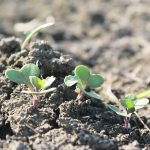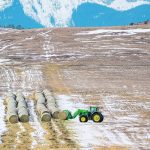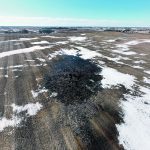Water volume trumps water use efficiency, says Philip Harder, research director and hydrological scientist at Croptimistic Technology.
Tag Archives Phillip Harder

Snow conditions work in Saskatchewan’s favour this year
A hydrologist says a good snowpack can provide more water than one may think, but steps are needed to keep it in the soil

Soil moisture deficit persists
Rainfall on the Prairies is much greater this year than last, though water expert Phillip Harder warns against setting high hopes for a continuing positive situation. “2023 winter, so Oct. 1 up until April 15, we had 140 millimetres of precipitation,” said Harder, research associate at the Global Institute for Water Security at the University […] Read more

Farmers aim for higher yields with less moisture
Trevor Hadwen says recent snowfall in many parts of the Prairies is welcome but is a “drop in the bucket” when it comes to rebuilding soil moisture reserves. The agroclimate specialist with Agriculture Canada’s National Agroclimate Information Service in Regina says a lot of the winter precipitation to date has been lost to the atmosphere. […] Read more

VIDEO: Alta. plans for water shortages
UPDATED – Video added to story January 16, 2024 – 1515 CST – MEDICINE HAT — An early January snowfall across the Prairies brought slight relief to dry conditions following one of the warmest, driest Decembers on record in Alberta and Saskatchewan, but drought concerns remain. Alberta is moving into high gear to co-ordinate agricultural, […] Read more

Soil-moisture management in dry times
Soil cores can be used to see if a field has enough moisture reserves to carry a crop, or if fertilizer rates should be cut
Prairie farmers who dealt with drought during the summer are now facing a soil moisture deficit in several areas as they cross their fingers for snowfall needed to help launch next spring’s growing season. Although precipitation this fall boosted soil moisture in some areas, “there’s definitely these pockets that have been extremely dry,” said Phillip […] Read more
Drones put to work tracking down water stress relationship
A University of Saskatchewan researcher is using drones to study the correlation between the thermal temperature of a plant and water stress, which typically means a shortness of water. “I’m using UAV (unmanned aerial vehicle) to collect the thermal electromagnetic radiation that comes off of crops and using that to correlate it to crop volumetric […] Read more





